Peace Lily, White Sails, Spathe Flower – Spathiphyllum wallisii
 Condensed Version:
Condensed Version:
Peace lilies are one of the most commonly known houseplants and also one of the easiest to grow. They will grow outdoors in warmer climates, thriving in moist, humid, frost free regions. In these regions they must be sited in semi-shade and protected from strong sunlight and strong winds. Exposure to direct light may cause yellowing leaves with a burnt appearance. Ensure that the soil is rich and drains well.
The dark-green, glossy leaves are strongly veined and arch away from the plant's base, making the peace lily an attractive foliage plant even when it’s not in bloom, but when in bloom, usually in early summer, it is truly lovely. What we call its flowers are actually pale green spathes, which turn white as they open. The plant produces offsets at the base and in time becomes a dense clump. A number of cultivars, are commercially available, all of which are essentially quite similar. Apart from one peace lily which produces a green flower and another that has variegated leaves, they all produce large green leaves and white flowers. Some have smaller leaves and an abundance of small flowers, while others produce large, glossier leaves and fewer, but much larger flowers. Peace lilies are used extensively as potted plants in shopping malls and offices and are a decorators dream because their lush green foliage compliments most styles, adding freshness to almost any spot in the home, and the striking white flowers will liven up any colour scheme.
Of all the indoor flowering plants, peace lilies are one of the easiest to care for, because they tolerate average indoor conditions better than many house plants. Although peace lilies are known to survive in darker spots in the home and do not like direct sunlight, they will bloom better if given bright, filtered natural light. Peace lilies thrive in fertile, well-drained soil and their fertiliser requirements are quite low, but in order to encourage blooms they must be fed with weakened solutions of liquid fertiliser every four to six weeks in summer. Although peace lilies growing in the wild love water, when potted they prefer an evenly moist soil which drains well, and is never allowed to dry out completely. These tropical plants love humidity, so if you live in a dry climate, creating a humid environment is beneficial to the plant. To do this, place the pot in a drip tray filled with small pebbles and water. The water will slowly evaporate and create more moisture in the air surrounding the plant, and the pebbles will ensure that the pot is not standing in the water, which can cause root rot. Mist spraying the leaves with water regularly will also help tremendously, and is especially important in dry climates and in air conditioned rooms. Unattractive leaves can be removed by following the leaf stem to the base of the plant and cutting it off at soil level. Spent blooms are removed in the same way.
Full Version:
Description, History & Interesting Facts:
Peace lilies are one of the most commonly known houseplants and also one of the easiest to grow. They may also be grown outdoors in frost free conditions. The NASA Clean Air Study found that these plants are fantastic for improving air quality indoors because they have one of the top removal rates of toxic solvents like formaldehyde, ammonia, benzene and carbon monoxide.
Of all the species found in the genus Spathiphyllum, all but three are found only in the New World Neotropics. The remaining three species are found in the Philippine and Molucca Islands, New Guinea, Palau, New Britain, and the Solomon Islands, while all the rest are found from tropical Mexico through Central and South America. The hybrids sold today originated from specimens gathered by collectors who went to South America in the 1800’s seeking new and interesting “house plants” for European growers. Spathiphyllum wallisii was discovered in the late 19th century growing wild in Central America, and is one of approximately 40 species of flowering plants in the family Araceae or arum family, which also includes Anthurium and Philodendron. These plants are members of a genus that loves water since they grow wild in the rain forests and commonly grow in and along the margins of streams and rivers; forming large colonies that are interconnected by their rhizomes. The genus also favours partially or periodically flooded forests, sometimes in sites with relatively low light intensities. The plants can naturally withstand abuse because in their natural habitat, they must survive through the dry season, which at times requires them to survive when little water is available.
The dark-green, glossy leaves are strongly veined and arch away from the plant's base, making the peace lily an attractive foliage plant even when it’s not in bloom, but when in bloom, usually in early summer, it is truly lovely. What we call its flowers are actually pale green spathes, which turn white as they open. Spathes are large sheathing bracts enclosing the flower spadix of certain plants. The spadix is a spike of minute flowers closely arranged around a fleshy axis and a characteristic of arum lilies.
Peace lilies in full bloom are sold in garden centres virtually all year round because growers use a chemical known as gibberellic acid to induce the plants to bloom, regardless of the season. Gibberellic acid is a natural plant hormone and is used in agriculture to stimulate both cell division and cell elongation that affects the leaves as well as the stems of a plant. A number of cultivars, are commercially available, all of which are essentially quite similar. Apart from one peace lily which produces a green flower and another that has variegated leaves, they all produce large green leaves and white flowers. Some have smaller leaves and an abundance of small flowers, while others produce large, glossier leaves and fewer, but much larger flowers.
 Spathiphyllum 'Sensation' Picture courtesy www.tuberflora.co.zaUses:
Spathiphyllum 'Sensation' Picture courtesy www.tuberflora.co.zaUses:
Peace lilies are used extensively as potted plants in shopping malls and offices and are renowned for improving air quality indoors. They are also sold by florists and make excellent gifts.
In the Garden and Home:
Peace lilies can be planted out into the garden or containers in frost free regions of the country. Indoors, they are a decorators dream because their lush green foliage compliments most styles, adding freshness to almost any spot in the home, and the striking white flowers will liven up any colour scheme.
Cultivation:
Of all the indoor flowering plants, peace lilies are one of the easiest to care for, because they tolerate average indoor conditions better than many house plants. However, most indoor plants are killed by either too much water, too little water or too much fertiliser and peace lilies are no different. Give this plant the right position indoors, water and feed correctly, and you will have a winner.
Although peace lilies are known to survive in darker spots in the home and do not like direct sunlight, they will bloom better if given bright, filtered natural light. Peace lilies thrive in fertile, well-drained soil and their fertiliser requirements are quite low, but in order to encourage blooms they must be fed with weakened solutions of liquid fertiliser (follow the instructions for indoor plants) eveyr four to six weeks in summer. Leaves with brown spots may be the result of over-fertilization (concentration could be too high).
Although peace lilies growing in the wild love water, when potted they prefer an evenly moist soil which drains well, and is never allowed to dry out completely. To simulate the dry season in their natural habitat, water potted plants less frequently in winter. Generally, in summer, watering your peace lily once a week should be sufficient. However, when the plant is grown in low light levels or cooler temperatures water requirements will be less. With brighter light levels or warmer temperatures and during periods of rapid growth, water requirements will increase. Test the soil before watering by sticking your finger into the potting soil up to the first knuckle and if the soil is still moist, don’t water. Overwatering may cause leaves to turn yellow and under watering may cause plants to wilt and the leaf edges to turn yellow or brown. If your plant does wilt badly, it will quickly recover if the pot is soaked in in a bucket of water for a while.
These tropical plants love humidity, so if you live in a dry climate, creating a humid environment is beneficial to the plant. To do this, place the pot in a drip tray filled with small pebbles and water. The water will slowly evaporate and create more moisture in the air surrounding the plant, and the pebbles will ensure that the pot is not standing in the water, which can cause root rot. Mist spraying the leaves with water regularly will also help tremendously, and is especially important in dry climates and in air conditioned rooms. Always use tepid water when watering or misting, and this is especially important during cold weather. Keep the leaves dust-free by wiping them with a damp cloth or by washing them down with a soft spray of water in the bath or sink. Unattractive leaves can be removed by following the leaf stem to the base of the plant and cutting it off at soil level. Spent blooms are removed in the same way.
Peace lilies should be re-potted when the root growth has filled the container. To help the roots to retain soil and prevent root tearing, re-pot the plant when the soil is somewhat moist. Select a container about one to two sizes bigger than the current one. Cover the drainage holes in your new pot with crocks or pebbles and lay down a layer of fresh potting soil. When placing the peace lily in its new pot, keep the plant at the same depth as it was in the old pot while filling with fresh soil around the plant. Gently press the soil down until the plant is firmly planted. Water well and wait a couple of weeks before feeding again.
Peace lilies will grow outdoors in warmer climates, thriving in moist, humid, frost free regions. In these regions they must be sited in semi-shade and protected from strong sunlight and strong winds. Exposure to direct light may cause yellowing leaves with a burnt appearance. Ensure that the soil is rich and drains well.
Peace Lilies are good candidates for hydroponics (a method of growing plants without soil) but are susceptible to chlorine damage in tap water, so allow the water to stand awhile before watering to allow the chlorine to evaporate. Distilled water and rainwater can also be used.
 Spathiphyllum wallisii 'Chopin' Picture courtesy www.tuberflora.co.zaPropagation:
Spathiphyllum wallisii 'Chopin' Picture courtesy www.tuberflora.co.zaPropagation:
You can create new peace lily plants by dividing them. Propagate by removing the plant from its container and gently shaking off the excess soil while gently teasing the sections apart. A sharp knife can be used to cut through some sections if necessary. Ensure that each divided section has sufficient roots. Re-pot into small pots to start off, using a rich, well-drained potting soil.
Problems, Pests & Diseases:
Without natural predators around, all house plants can succumb to insect problems, but these are very minimal with peace lilies. They can be susceptible to insects like aphids, black scale, spider mites and mealy bugs. Insect problems can be taken care of with insecticides, insecticidal soap or by washing the plant with water.
Many gardeners and growers attribute the death of peace lilies to excessive watering, but although this may often be the case, the main reason for the demise of most plants is a combination of poor soil that is kept soggy, poor light conditions, near constant neglect and a lack of nutrients, or at the other extreme, an overdose of fertiliser. Overwatering may cause leaves to turn yellow and under watering may cause plants to wilt and the leaf edges to turn yellow or brown. Root rot, leaf spot and bacterial soft rot can occur in peace lilies, but are usually the result of improper care and bad drainage
If you are feeding your plant but it still does not bloom well, you need to move it to a location with bright, filtered light. Older plants may also just need to be re-potted or divided. This is one of the few plants that bloom’s better after dividing it.
If the leaves become shrivelled and dry, the humidity is too low; and if the leaf tips start to brown, it can be a result of direct sun, over-fertilising or under-watering.
Warning:
True lilies from the Liliaceae family are much more toxic to cats and dogs than the peace lily, which is not a true lily and is only mildly toxic to humans and animals when ingested. The Peace Lily contains calcium oxalate crystals, which can cause skin irritation, a burning sensation in the mouth, difficulty swallowing, and nausea, so keep it away from children and pets who may play with or chew on it.
Croton - Codiaeum
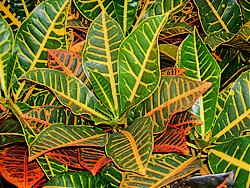 Crotons are native to tropical Asia and the western Pacific region.
Crotons are native to tropical Asia and the western Pacific region.
They are grown for their vibrantly coloured leaves in many amazing shades and combinations of colours. Their leaves also vary in shape and size. Drooping clusters of small star-shaped yellow flowers appear in summer.
They require a warm position indoors with bright light, but no direct sun. Crotons hate draughts and sudden changes in temperature. Water regularly in summer, less in winter and feed every two weeks in summer. Spray the leaves with tepid water often, to increase humidity around the plant.
These plants are grown outdoors in moist, humid, sub-tropical regions in semi-shade to sun. Plant them in rich, well-drained soil and they will grow quickly to +-1.8m tall and +-1.2m wide, depending on the variety.
Chrysanthemum - Chrysanthemum x grandiflorum
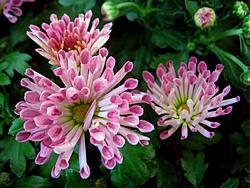 These alluring pot plants originate in East Asia and there are about 40 species. In China they symbolise longevity and happiness and have been cultivated for over 2,500 years.
These alluring pot plants originate in East Asia and there are about 40 species. In China they symbolise longevity and happiness and have been cultivated for over 2,500 years.
Their exquisite shapes and kaleidoscope of colours ensure that there is the perfect shade to match your decor. Chrysanthemums are available year round and will bloom indoors for about 4 weeks, without breaking the budget.
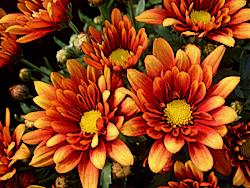 Place them in a warm, bright position indoors; some direct sunlight will not harm them. Keep the soil moist but not soggy; but never allow the plant to wilt from lack of water. The trick is to water them thoroughly and then to allow the soil to almost totally dry out before watering again.
Place them in a warm, bright position indoors; some direct sunlight will not harm them. Keep the soil moist but not soggy; but never allow the plant to wilt from lack of water. The trick is to water them thoroughly and then to allow the soil to almost totally dry out before watering again.
When they have finished flowering indoors you can prune them down and plant them into the garden. Chrysanthemums prefer fertile well-drained soil and full sun. In extremely hot, dry regions you can plant them in semi-shade; try to shelter them from the fierce midday heat. To increase bloom production pinch out the new growth each time it reaches 15cm long.
Chrysanthemums bloom prolifically and are therefore heavy feeders, so fertilise regularly in the growing season. The plants can be propagated from cuttings or by division of the plants in spring.
Barberton Daisy - Gerbera hybrids
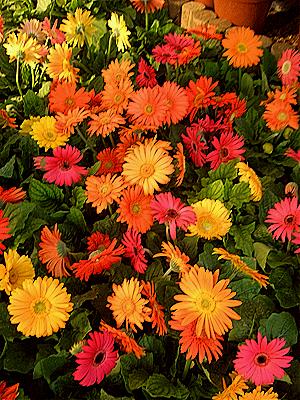
![]() These cheerful South African plants will produce flowers for many months in summer if placed in a warm room with bright light. They are specially bred to grow indoors and dont like too much direct sun, but a touch of morning sun won't harm them.
These cheerful South African plants will produce flowers for many months in summer if placed in a warm room with bright light. They are specially bred to grow indoors and dont like too much direct sun, but a touch of morning sun won't harm them.
Water them regularly in summer, less in winter and feed them every two weeks when they are in full bloom. Barberton Daisies require very well drained soil, so mix one part good potting soil with one part washed river sand to ensure good drainage. They will grow +-30cm tall +-30cm wide.
They can be grown outdoors in summer in pots, window boxes, and even in the garden if the above requirements are met. Try planting them in pots on the patio, or in rows in window boxes at your entrance. They are bound to attract attention with their unusual colors.
African Violet - Saintpaulia ionantha cultivars
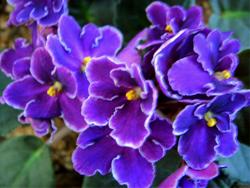 African Violets are popular worldwide and are grown for their profusion of single or double flowers almost all year round.
African Violets are popular worldwide and are grown for their profusion of single or double flowers almost all year round.
Grow them in a warm, bright room. Their leaves scorch in direct sunlight. Water them from the bottom drip tray or around the top rim of the pot. Empty the drip tray when the soil is moist. Keep the soil from drying out totally, but do not over water.
Do not wet the leaves, but rather remove dust by brushing the leaves with a soft brush. Feed African Violets every two weeks in summer, but allow your plant to rest without food in the winter. Re-pot every two years into a slightly bigger container, using special African Violet Soil from your nursery.
Cyclamen, Florists Cyclamen
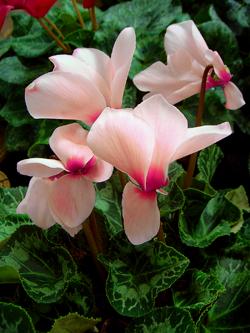 Condensed Version:
Condensed Version:
Cyclamens never fail to delight gardeners with their swept-back flower petals resembling shooting stars, and their heart-shaped leaves embroidered with intricate, silvery patterns. They are hugely popular indoor pot plants, but will also grow outdoors, and if cared for correctly, the plants will bloom continuously all winter and spring. Sadly, however, most will wither and die, much to the horror of their owners! The good news is, if you provide cyclamens with the conditions they love, they will multiply and miraculously appear again every autumn when the weather cools down, freely providing their abundance of beautiful blooms year after year.
Hybridization has spoiled us for choice concerning colour, and today cyclamens are found in many single and bi-coloured shades of lavender, pink, rose, maroon, red, or white. Modern cyclamen hybrids also have many interesting flower traits including size, ruffled petals and double flowers.
The florists’ cyclamen is tender to frost but can be grown outdoors in frosty regions, as long as the plants are sited beneath evergreen trees and shrubs, or under a roof or overhang, which will protect them from frost. Also, select a sheltered spot, away from freezing cold winds. If you are planting tubers or potted plants into garden beds, ensure that you do not plant too deep, ensuring that the top of the tuber is still visible above the soil.
Cyclamens growing outdoors thrive in dappled shade, and indoors they like good light but no direct sunlight. They are very tolerant of diverse soil types, as long as they are reasonably fertile and drain well. If you feed your cyclamen during the growing season, using a regular houseplant fertiliser for flowering plants, it will reward you will blooms continually.
The plant is a bit fussy about watering and more plants die from overwatering than under watering, so allow the soil to almost dry out completely before watering. Also, the plant can rot from the crown if watered overhead, making drip irrigation perfect for cyclamens growing in garden beds. Potted plants should be watered from the bottom, or the leaves can be gently lifted and the plant watered around the edge of the pot - not over the tuber. The easiest way to water potted plants is to stand the pot in a shallow drip tray filled with water. Allow the plant to soak up what it needs before discarding the excess water. Do not allow the plant to constantly stand in a tray of water.
Because cyclamens do not like heat, and temperatures above 20°C may induce the plant to go dormant, one of the tricks to growing them successfully is to keep them cool. This is especially important if you are growing them indoors, so keep them well away from heat sources, and do not place them in hot rooms.
To keep plants blooming, remove flowers as they finish by cutting the stems near the base of the plant. Sometimes the petals will fall off and leave a round seed capsule that resembles a flower bud - remove these too, as well as any unsightly yellow or withered leaves.
As the weather warms up in early summer, cyclamens growing in the wild naturally go dormant, but in gardens where they receive summer watering, the leaves may persist. This is not a problem as long as rainfall is not excessive and the soil has perfect drainage. Because it is best to leave the tubers virtually dry during their summer rest period, many gardeners move their potted specimens to a spot outdoors which is sheltered from excessive rainfall and heat. As the growth cycle starts again in autumn, start watering and feeding regularly again.
 Cyclamen 'Frille'r Scarlet. Picture courtesy www.ballstraathof.co.zaFull Version:
Cyclamen 'Frille'r Scarlet. Picture courtesy www.ballstraathof.co.zaFull Version:
Description, History & Interesting Facts:
Florists’ cyclamens never fail to delight gardeners with their swept-back flower petals resembling shooting stars, and their heart-shaped leaves embroidered with intricate, silvery patterns. They start showing up in grocery stores and garden centres throughout South Africa in autumn, and for many people their first encounter with these fascinating plants is when they are given one as a gift. If cared for correctly the plants will bloom continuously all winter and spring, but sadly most will wither and die, much to the horror of their owners! The good news is, if you provide cyclamens with the conditions they love, they will multiply and miraculously appear again every autumn when the weather cools down, freely providing their abundance of beautiful blooms year after year.
Cyclamens belong to the beautiful Primrose (Primulaceae) family of plants and the Florists Cyclamen (Cyclamen persicum) is only one of 23 species, but by far the most well-known. It was introduced in Europe at the end of the 16th century, but for a long time remained a rare curiosity in specialty collections.
There are many rich stories about cyclamen, and at the beginning of the 16th century Leonardo Da Vinci favoured the cyclamen and columbine by covering the margins of his manuscripts with them. The 17th century Flemish painters scattered cyclamens on the meadows of their paintings depicting Jesus picking flowers under the watchful eye of the angels. Louis XIV received them in bunches, along with many other flowers, to adorn the lounges of Versailles, and Jean-Jacques Rousseau spoke in his ‘Promenades’ of the wild cyclamens he discovered in the Alps. By the 1800s the cyclamen was prized by the Victorians for its winter colour, and quickly became a popular Christmas decoration - a tradition that has grown into a huge business today. So enamoured were the Victorians that they started breeding with the plant, and this led to the multitudinous number of cultivars that we see today.
Cyclamen persicum, the wild species from which the many florists cyclamen hybrids are derived, grows in a typically Mediterranean climate with hot dry summers and warm wet winters. In these regions it can grow in great drifts of thousands of plants, filling the air with their sweet scent. Cyclamens also grow wild in North Africa, the eastern Aegean and the northeast corner of the Mediterranean. They are found in Algeria, Tunisia, Karpathos, Rhodes, Symi, Chios, Cyprus; and from mainland Turkey through Syria, Lebanon, Israel and into Jordan.
Cyclamens thrive from sea level to 1200m, mainly in open situations, on “terra rossa” soils. Terra rossa is Italian for "red soil" and this type of red clay, typical in Mediterranean climates, is produced by the weathering of limestone. When limestone weathers, the clay contained in the rocks is left behind, along with any other non-soluble rock material. Under oxidizing conditions, when the soils are above the water table, iron oxide (rust) forms in the clay, giving it a characteristic red to orange colour. Compared to most clay soils, terra rossa has surprisingly good drainage characteristics, making it a popular soil type for wine production.
Most of the work with florist cyclamens occurred in England, Netherlands, Germany, and Japan. Hybridization has spoiled us for choice concerning colour, and today cyclamens are found in many single and bi-coloured shades of lavender, pink, rose, maroon, red, or white; including breakthrough hues like true red and pale yellow. Modern cyclamens also have many interesting flower traits, including size, ruffled petals, double flowers, and the delightful ‘picotee’ flowers, whose edges are a different colour than the flower's base colour.
New cultivation methods and new F1 hybrid varieties now also offer longer-lasting, hardier and more regular flowering varieties. More recently, hybridization efforts have focused on re-introducing the lovely scent of cyclamens, which was sadly lost during the development of larger plants, so watch out for these.
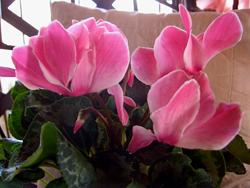 Uses:
Uses:
Although cyclamens have been used as ornamentals for the last 400 years or so, they have been used medicinally for over 2000 years. The Greek doctor and botanist, Dioscorides, documented several medical uses for cyclamen that include its use as a purgative, to speed up the delivery of babies, to cause abortions, to make hair re-grow, and as an amorous medicine which caused the person taking it to fall violently in love. The Roman naturalist, Pliny the Elder, described how cyclamen tubers and roots were used to poison fish.
If eaten raw, cyclamen tubers are poisonous to people and can cause violent diarrhoea and even death, however, people in the Near East, dry and roast the tubers to break down the toxins, and eat it as a delicacy. Cyclamen flower petals are also used around the world to make tea.
 Cyclamen 'Smartiz' Mix. Picture courtesy www.ballstraathof.co.zaIn the Garden and Home:
Cyclamen 'Smartiz' Mix. Picture courtesy www.ballstraathof.co.zaIn the Garden and Home:
Florist’s cyclamens are hugely popular as houseplants, but if given the right conditions will also flourish outdoors in garden beds or containers. They bloom in autumn, winter and spring, providing colour when little else is flowering, particularly in late winter or early spring. Cyclamens are highly recommended for window boxes, hanging baskets and pots. They are also ideal for naturalising under trees, on banks or in a shady border, together with other early-flowering woodland plants such as snowdrops and primroses.
Because cyclamens have been bred for more than 150 years, we now have an astounding selection to choose from, in a beautiful range of flower colours. Breeders have concentrated on increasing the extent and intensity of the leaf patterning on the gorgeous heart-shaped leaves. They have also developed all sizes, from small miniature plants which flower profusely to stunning giant varieties, with huge flowers and leaves - and every size in-between! Whether you have space for only one small pot indoors or on your balcony, or want a massed display in the garden, there is a perfect cyclamen just for you.
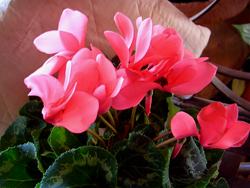 Cultivation:
Cultivation:
Some species of cyclamen are hardier than others, but the florists’ cyclamen is tender to frost. However, it can be grown outdoors in frosty regions as long as the plants are sited beneath evergreen trees and shrubs, or under a roof or overhang, which will protect them from frost. Also, select a sheltered spot, away from freezing cold winds. If you are planting tubers or potted plants into garden beds, ensure that you do not plant too deep, ensuring that the top of the tuber is still visible above the soil.
Cyclamens growing outdoors thrive in dappled shade, and indoors they like good light but no direct sunlight. Although cyclamens grow extremely well in slightly alkaline soils, they are very tolerant of diverse soil types, as long as they are reasonably fertile and drain well. If you feed your cyclamen during the growing season, using a regular houseplant fertiliser for flowering plants, it will reward you will blooms continually.
The plant is a bit fussy about watering and more plants die from overwatering than under watering, so allow the soil to almost dry out completely before watering. Also, the plant can rot from the crown if watered overhead, making drip irrigation perfect for cyclamens growing in garden beds. Potted plants should be watered from the bottom, or the leaves can be gently lifted and the plant watered around the edge of the pot - not over the tuber. The easiest way to water potted plants is to stand the pot in a shallow drip tray filled with water. Allow the plant to soak up what it needs before discarding the excess water. Do not allow the plant to constantly stand in a tray of water.
Because cyclamens do not like heat, and temperatures above 20°C may induce the plant to go dormant, one of the tricks to growing them successfully is to keep them cool. This is especially important if you are growing them indoors, so keep them well away from heat sources, and do not place them in hot rooms.
To keep plants blooming, remove flowers as they finish by cutting the stems near the base of the plant. Sometimes the petals will fall off and leave a round seed capsule that resembles a flower bud - remove these too, as well as any unsightly yellow or withered leaves.
As the weather warms up in early summer, cyclamens growing in the wild naturally go dormant, but in gardens where they receive summer watering, the leaves may persist. This is not a problem as long as rainfall is not excessive and the soil has perfect drainage. Because it is best to leave the tubers virtually dry during their summer rest period, many gardeners move their potted specimens to a spot outdoors which is sheltered from excessive rainfall and heat. As the growth cycle starts again in autumn, start watering and feeding regularly again.
 Cyclamen 'Silverado' Purple Flame Mix. Picture courtesy www.ballstraathof.co.zaPropagation:
Cyclamen 'Silverado' Purple Flame Mix. Picture courtesy www.ballstraathof.co.zaPropagation:
Cyclamens can be propagated by seed or division of the tubers. Tubers can be gently lifted and divided in winter when the plant is dormant, and seed can be collected at home and sown immediately.
The fruit is a round pod that, at maturity, opens by several flaps or teeth and contains numerous sticky seeds Natural seed dispersal is by ants, which eat the sticky covering and then discard the seeds. So, you need to collect the seed after they are mature, but before the fruit opens. Ripening seed changes colour from white to light brown, turning dark brown when fully mature. If the plants are happy where they are growing, they will self-seed themselves in the garden.
Since the seeds have no dormancy requirements, they are best sown fresh and will germinate in 2 to 4 weeks. They can also be dried and stored for a year or so if needed, but the longer the seeds have been stored, the more erratic the germination will be. Soak the seeds overnight in warm water before sowing. Use a mixture of equal parts seed compost and washed river sand, and cover the seeds carefully with a thin layer of fine compost, as light can inhibit germination. Mist the soil to moisten it lightly, and cover the container in a clear plastic bag.
Keep in light shade, at a minimum temperature of 16°C. The germinating seeds will first form a small tuber, followed by a single leaf, and at this early stage they can be planted into small, 6-pack seedling trays to grow on until they are transplanted into their individual pots. With good care, your cyclamen should start to flower in about 18 months, at which point they can be planted into the garden.
![]() Pests & Diseases:
Pests & Diseases:
If cared for properly, cyclamens are relatively pest and disease free, but they are susceptible to botrytis or grey mould, which occurs mostly in cool, humid conditions. If you notice this greyish growth on your plants, spray the plant thoroughly with a fungicide, and remove the dead leaves and flowers. They can occasionally be attacked by aphids, thrips and mites, but these are easily controlled with organic sprays.
Caution: Cyclamen is toxic to dogs and cats. If ingested, this plant can cause increased salivation, vomiting, and diarrhoea. If an animal ingests a large amount of the plant’s tubers, heart rhythm abnormalities, seizures, and even death can occur. Raw cyclamen tubers are poisonous to people too, so keep them away from small children and pets.
Begonia - Begonia x tuberhybrida
 This popular indoor plant is grown for its beautiful flowers for many weeks. They are available all year round; in full bloom. The double flowers are available in shades of pink and white, yellow, orange and red.
This popular indoor plant is grown for its beautiful flowers for many weeks. They are available all year round; in full bloom. The double flowers are available in shades of pink and white, yellow, orange and red.
They can be grown outdoors in summer in temperate regions in a secluded, shady garden bed or on a secluded patio. The soil must be enriched but very well-drained. Try burying the flowering pots into window boxes or hanging baskets etc. for 'instant colour'.
Place it in bright, indirect light indoors and keep the atmosphere moist, by mist spraying the leaves with tepid water daily. Never allow the soil to totally dry out and feed it regularly with a flowering, pot plant food.
It is best to discard the tuber after flowering.
Queensland Umbrella Tree - Schefflera arboricola 'Variegata'
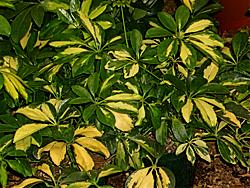 Schefflera arboricola This handsome plant comes from Australia, New Guinea and Java. It is grown for its glossy leaves and bushy growth.
Schefflera arboricola This handsome plant comes from Australia, New Guinea and Java. It is grown for its glossy leaves and bushy growth.
It is easy to grow almost anywhere, but grows best in a warm, bright room. It will however, tolerate poor light and is used extensively in offices etc, as it does not require high maintenance. Spray the leaves down with water often and water it regularly in summer, less in winter. Feed every two weeks in summer.
This plant can be grown outdoors in sun or shade and is hardy to moderate frost if planted in a protected position outdoors. It varies in height and can grow into a small tree in the tropics. Prune it into shape anytime.


